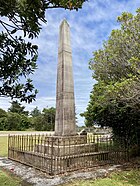Talk:Westland Explorers' Monument
Appearance
A fact from Westland Explorers' Monument appeared on Wikipedia's Main Page in the Did you know column on 7 November 2022 (check views). The text of the entry was as follows:
|  |
| This article is rated B-class on Wikipedia's content assessment scale. It is of interest to the following WikiProjects: | |||||||||||||||||||||
| |||||||||||||||||||||
Did you know nomination
[edit]- The following is an archived discussion of the DYK nomination of the article below. Please do not modify this page. Subsequent comments should be made on the appropriate discussion page (such as this nomination's talk page, the article's talk page or Wikipedia talk:Did you know), unless there is consensus to re-open the discussion at this page. No further edits should be made to this page.
The result was: promoted by RoySmith (talk) 14:54, 3 November 2022 (UTC)
( )

the monument at Hokitika Cemetery
- ... that the Westland Explorers' Monument (pictured), placed within an intersection, was seen as an obstruction and relocated, only to be replaced with an even larger monument? Source: Original monument: The base on which it will rest will be of three tiers, each one foot deep, the lowest tier will be eight, the next six, and the topmost one four feet square. The Memorial Clock Tower is approximately 11 metres in height and its base is 3.35 metres square, which is 11 feet square. The monument is an obstruction where it is.
- Reviewed: Template:Did you know nominations/Shura Council (Yemen)
- Comment: Open to other hooks, but this one seems reasonably interesting.
Created by Schwede66 (talk). Self-nominated at 20:16, 21 October 2022 (UTC).
| General: Article is new enough and long enough |
|---|
| Policy: Article is sourced, neutral, and free of copyright problems |
|---|
|
| Hook: Hook has been verified by provided inline citation |
|---|
|
| QPQ: Done. |
Overall: ![]() @Schwede66: Good article! QPQ is done, article is new enough and cited (though I wish there more sources than the West Coast Times), and the hook is interesting.
@Schwede66: Good article! QPQ is done, article is new enough and cited (though I wish there more sources than the West Coast Times), and the hook is interesting. ![]() Approving. Onegreatjoke (talk) 01:29, 23 October 2022 (UTC)
Approving. Onegreatjoke (talk) 01:29, 23 October 2022 (UTC)
- Thanks for the review, Onegreatjoke. You say:
I wish there more sources than the West Coast Times
. I suppose it's difficult to imagine just how remote a place Hokitika was at the time. The closest place nearby that had a newspaper was Kumara (they had a newspaper from 1876). It seems that by coach, it took some 5 hours to get there. Greymouth, which is bigger, was a tad further away and they had their first newspaper in 1865. Initially, it was easier to get to Greymouth via sea than by land, with frequent loss of ships and lives when going over the respective river bars (e.g. Charles Townsend). For the land journey, the biggest issue was getting across the Taramakau River (where Henry Whitcombe had drowned) and I assume that they had a ferry before a "wire tram" was built in 1878 with a span of 740 feet (230 m) (the article has a photo of it). Hence, that's why you don't get much reporting from other papers; every place of noteworthiness was half-a-day's travel away. Schwede66 22:22, 31 October 2022 (UTC)


